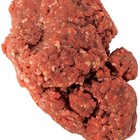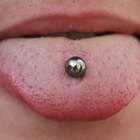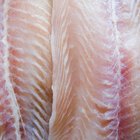
Since presentation is a vital element of Japanese cuisine, restaurants serving sushi and sashimi value sockeye salmon not only for its flavor and silky texture but also for the eye appeal of its vivid color. This fish, the third most abundant of seven Pacific salmon species, is very safe to eat raw -- as long as the Food and Drug Administration's guidelines for neutralizing the risks of transmitting parasites have been followed. If not, the potential health consequences aren't worth the gamble.
Tapeworm
Salmon is the main vector for transmitting tapeworm to humans. Symptoms include nausea, abdominal pain, diarrhea, and weakness. Dr. Felipe C. Cabello, professor of Microbiology and Immunology at New York Medical College in Valhalla, told ABC News, "This is a worm that can reach 25 feet and it might take months, a year to grow." Since the tapeworm absorbs vitamin B12, the host human doesn't get enough, Cabello says. According to the Mayo Clinic, if the worm migrates from the intestinal tract to other organs, some very unpleasant complications can result; if not, a course of treatment with drugs usually gets rid of it. Since it's not contagious, infections don't have to be reported to public health authorities, which means that no clear picture of current prevalence exists.
Anisakis Worms
Anisakiasis, caused by ingesting the larvae of the anisakis worm, is most common in countries such as Japan, where raw fish is often eaten. But as the practice of eating sushi and sashimi has spread, so has the prevalence of this disease, which has now been reported around the world. Among Pacific-caught salmon, including the sockeye, one study cited by the FDA, published in 1990 in the journal "Microbiology of Marine Food Products," put the prevalence of the worm in salmon sold in the US at more than 75 percent. The worms attach themselves to the walls of the esophagus, stomach or intestines. Sometimes, people experience "a tingling sensation" after eating a piece of raw fish, says the CDC, and "this is actually the worm moving in the mouth or throat." Eventually, the worms die, but may leave behind an inflamed mass at the site of the infection which can only be removed surgically.
Highly Allergenic
Symptoms that an anisakis worm has taken up residence in your body include abdominal pain, bloody diarrhea and vomiting -- but this isn't necessarily the worst it can do. A paper published in the April 2008 issue of "Clinical Microbiology Reviews" notes that allergic reactions, with consequences ranging from mild to lethal, are so common that testing for exposure to the worm has become a standard part of investigating food allergies. Among people allergic to anasakis, severe reactions can be triggered by exposure to the worms, dead or alive, through food, air or skin contact. More than 90 percent of the cases cited by the researchers, who blame "traditions of consumption of raw or undercooked fish, including sushi and sashimi," were caused by a single larva.
Dining Out
On restaurant menus, items that might feature uncooked sockeye salmon include sushi, sashimi, ceviche, lox, gravlax and tartare. Despite widespread misconceptions to the contrary, salting, cold-smoking, brining and marinading in citrus juice aren't equivalent to cooking with heat to eliminate threats from parasites. These processes have little to no effect on worms, says the FDA. Even though anisakis appears to be sensitive to salt, the amount required and the time needed for it to kill the worm larvae makes the process impractical. For example, a paper published in 1995 in the journal "Food Science and Technology" reported that worm larvae in herring were only killed after being marinaded for five to six weeks in an 8 to 9 percent salt solution. Because of this, freezing is the sole method endorsed by the FDA for killing worm larvae that might be lurking in the flesh of fish intended to be eaten raw. It's up to local and state public health authorities to enact laws based on these recommendations, and ensure that restaurants and retail establishments, such as delis, that sell takeout raw fish products comply. If it's properly frozen, sockeye salmon is safe to eat raw.
Buying Fish
Industrial freezers such as those found in supermarkets typically reach much lower temperatures than home freezers, so the FDA recommends that if you plan to eat fish raw, you should buy it frozen and thaw it in the fridge. As tempting as fresh sockeye salmon might look at the fishmonger's, the only way you can be confident that the fish is worm-free without cooking it is by freezing it for at least seven days -- but only if your home freezer's temperature never strays above -4 degrees Fahrenheit. The FDA suggests buying a freezer thermometer, leaving it permanently inside in an easy-to-read spot, and checking it at least once a week.
Related Articles

Canned Salmon and Metal Toxins

Is Grocery Store Fish Safe for Sushi?

Can You Cook Sushi-Grade Salmon?

Dangers of Spoiled Ground Beef

Is it Healthier to Cook Salmon With Its ...

Dimethicone Hazards

Dangers of Spray on Tan

How to Use Colloidal Silver to Kill ...

How Long Does Tilapia Last Refrigerated?

How Long Does It Take for Salmon to ...

Can You Cook Meat Gone Bad?

Benefits of Raw Milk

Is Orange Roughy Safe to Eat?

How Dangerous Is It to Pierce Your ...

Foods Containing Nitrates

Dangers of Goat Milk

Can You Eat Sour Cream If It's Been ...

Causes of Fishy Odors on Clothes

How to Fillet a Black Cod Fish

List of Biodegradable, Every Day ...
References
- ABC News: Eat Raw Fish . . . Get a 9-Foot Tapeworm
- U.S. Food and Drug Administration: Processing Parameters Needed to Control Pathogens in Cold Smoked Fish -- Chapter V: Potential Hazards in Cold-Smoked Fish; Parasites
- Seafood Health Facts: Seafood Safety
- Clinical Microbiology Reviews: Anisakis simplex -- From Obscure Infectious Worm to Inducer of Immune Hypersensitivity; M. Teresa Audicana et al; April 2008
- National Geographic: Sockeye Salmon
- Centers for Disease Control and Prevention: Parasites -- Anisakiasis
- Salt Lake Valley Health Department: Why We Care about Parasites Found in Fish
- Mayo Clinic: Tapeworm Infection -- Treatments and Drugs
- U.S. Food and Drug Administration: For Consumers -- Are You Storing Food Safely?
Resources
Photo Credits
Creatas/Creatas/Getty Images